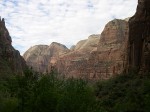 When I was planning a fall trip to Zion National Park in southwestern Utah I thought I would see rocks, rocks, and more rocks and did not think that the flora would be of much interest. I was very wrong and found instead a beautiful and interesting array of plant life.
When I was planning a fall trip to Zion National Park in southwestern Utah I thought I would see rocks, rocks, and more rocks and did not think that the flora would be of much interest. I was very wrong and found instead a beautiful and interesting array of plant life.
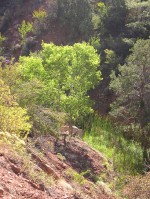 Zion lies on the Colorado Plateau bordering the Basin and Range Province so has plants from both regions. Uplift, erosion, and sedimentation have resulted in elevations from 3,600 to 8,700 feet, providing many diverse environments including high plateaus, canyons, deserts, slickrock, wetlands, and hanging gardens. Each area has its own characteristic vegetation so that Zion contains over 800 different species of trees, shrubs, and herbaceous plants. Here is a sampling of the wildflowers you might find if you visited during September.
Zion lies on the Colorado Plateau bordering the Basin and Range Province so has plants from both regions. Uplift, erosion, and sedimentation have resulted in elevations from 3,600 to 8,700 feet, providing many diverse environments including high plateaus, canyons, deserts, slickrock, wetlands, and hanging gardens. Each area has its own characteristic vegetation so that Zion contains over 800 different species of trees, shrubs, and herbaceous plants. Here is a sampling of the wildflowers you might find if you visited during September.
At lower elevations the most conspicuous plant is Sacred Datura (Datura wrightii) with its large white flowers and gray foliage that smells like a wet dog. The seeds and flowers of the plants contain alkaloids such as scopolamine, hyoscyamine, and atropine and so are poisonous and hallucinogenic.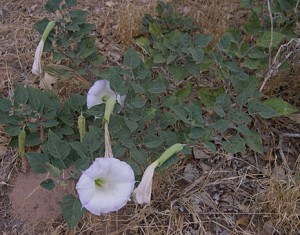
The beautiful white flowers, appearing from spring through autumn, are sometimes tinted with shades of lavender and are sweetly scented.
The buds of Sacred Datura are long and thin and open in late afternoon or evening.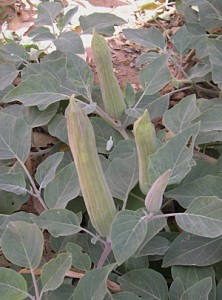
The fruit is relatively large and spiny.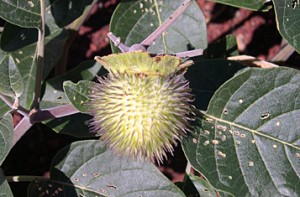
The lovely lemon yellow flowers of Yellow Camissonia (Camissonia multijuga) open during the day and remain open in the evening long enough to attract hawkmoths although they are also pollinated by bees and other insects. The plants my be found on the lower slopes of the Watchman trail.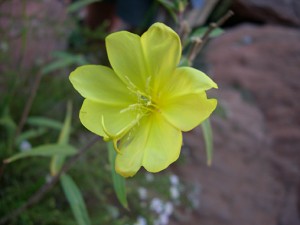
Two types of Yucca grow in the lower elevations especially in sandy sites. Both bloom in the spring but they make a strong statement in the landscape all season due to their architectural qualities. Yucca utahensis is the most common and may form large colonies.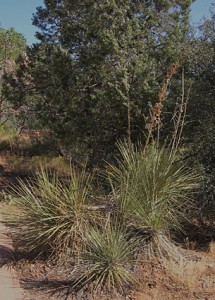
Spanish Bayonet/Datil yucca (Yucca baccata) contains strong fibers in its leaves that Indians used for such diverse items as thread, cloth, baskets, mats, and sandals. The berries were used to make a sweet soup.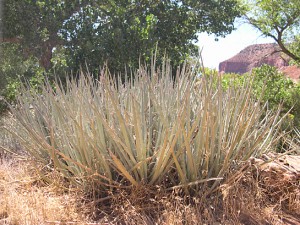
The curly strings on the edges of the leaves add to the over all attractiveness of the plant.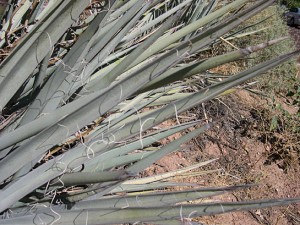
Paintbrush (Castilleja sp) usually blooms in lower elevations in the spring but reblooms in the fall.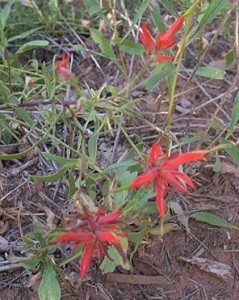
Its bright scarlet bracts and sepals that appear to be the flowers are just as welcome in the fall although they are not as robust as the early ones.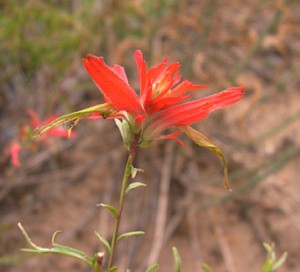
Button brittlebush (Encelia frutescens) grows well in the shrub land of lower elevations in early and late summer. It is one of the first plants to establish itself in a disturbed or burned area.
The flowers are unusual because they look like the center of a daisy, that is, a daisy without its outer white ray petals.
Fragrant sand verbena (Abronia fragrans) likes sandy sites. It opens its delicate flowers late in the day or in the evening when it can attract hawkeye moths.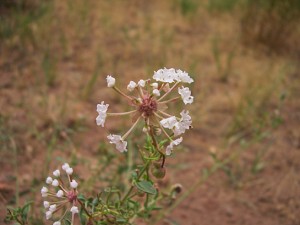
Purple asters bloom in many places in the park including the areas where people walk and damage the environment.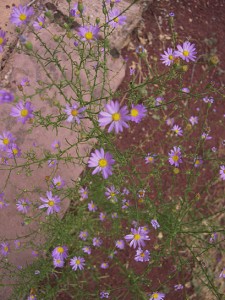
Goldenrod (Solidago sp) is found in dry areas too, sometimes growing in crevices.
When the aster and goldenrod grow together they make a nice combination when the yellow of the golden rod flowers echoes the bright yellow center of the aster.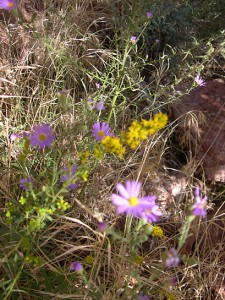
Prickly pear cactus (Opuntia phaeacantha) is common in sandy desert areas, canyons, talus slopes and mesas. It bears a yellow to apricot flower often streaked with red or orange in spring or early summer.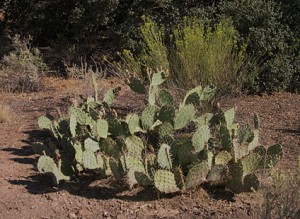
The fruit or prickly pear ripens to a reddish or purplish berry and is edible when ripe.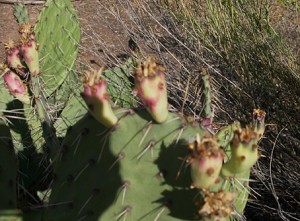
Whipple cholla (Opuntia whipple) is an attractive cactus found planted in sandy, desert areas and canyons and has been planted in the median strip outside the museum.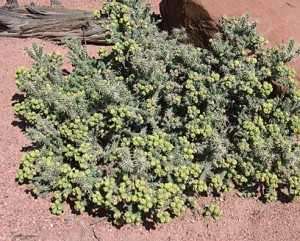
It flowers in early summer and bears handsome fruits into fall. The fruits and flesh were eaten by the Indians boiled with squash.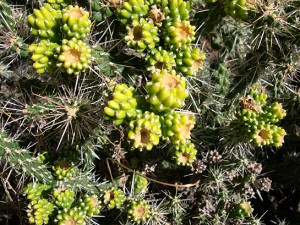
The red flowers of Arizona thistle (Cirsium arizonicum) can be seen from May through October in dry areas throughout the Park. The flower heads may be up to 2’ long and have spiny bracts at their base. The plant grows up to 4’ tall and bare spiny leaves.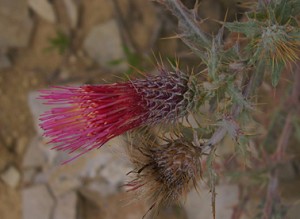
The hummingbird flower (Zauschneria latifolia), a cousin of fushia, blooms summer through fall in the crevices of slickrock.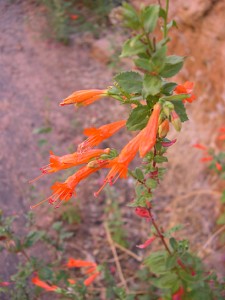
Rock spiraea (Petrophytum caespitosum) forms dense blue green mats on cliff walls and in hanging gardens throughout the Park. Its dense white flower heads appear in summer through fall.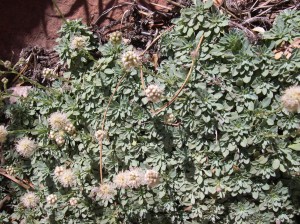
Scarlet gila (Ipomopsis aggregata) may be found on slopes at high elevations May to September where its star like, flared petals attract hummingbirds. They also attract bees but the flowers are too narrow for the bees to enter and the bees drill holes in the corolla to get to the nectar. It is hard to believe that such pretty flowers give off the odor of skunk.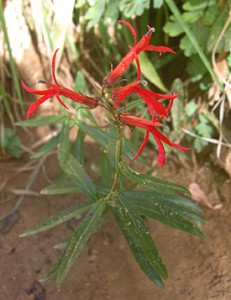
The Park has many moist and wet areas. Some of the prettiest are the weeping walls where moisture loving plants may be found.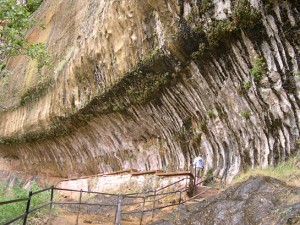
The delicate fronds of maidenhair fern (Adiantum sp.) are an important feature of many hanging gardens.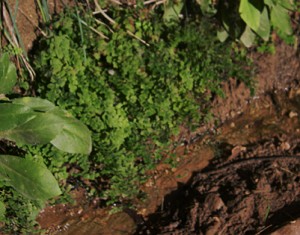
The orange flowers of monkey flower (Mimulus cardinalis) bright up a hanging garden.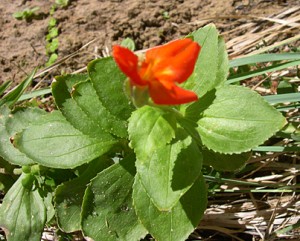
Scarlet lobelia (Lobelia cardinalis) is another moisture loving plant that is found around hanging gardens. The Indians used to use the roots and other parts to treat syphilis and intestinal problems but the plant is considered poisonous to humans.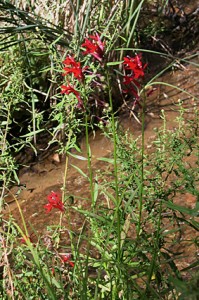
Quite a different look is provided by deadly night shade (Atropa belladonna) that has naturalized in the Park and is very evident in the Watchman campground.
The foliage, berries and root are considered toxic and contain alkaloids including scopolamine and hyoscyamine which are hallucinatory. Witches are said to use deadly nightshade in their brew and the ancient Romans used it as a poison. The berries are sweet tasting and attractive to children. As few 2-5 berries can be lethal so KEEP CHILDREN AWAY FROM THIS PLANT!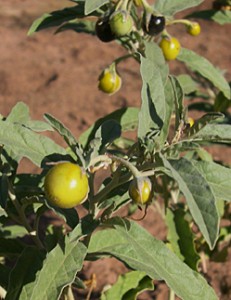
Nothing has been said here about the shrubs and trees but they are the backdrop for the herbaceous plants and add a whole different dimension to the flora. Part II highlights these wonderful plants.

might your shooting star be a deadly nightshade – http://tinyurl.com/yab57bj
Kari,
You are right…my mistake; thanks for the correction. i will change the information in the post immediately. Karen